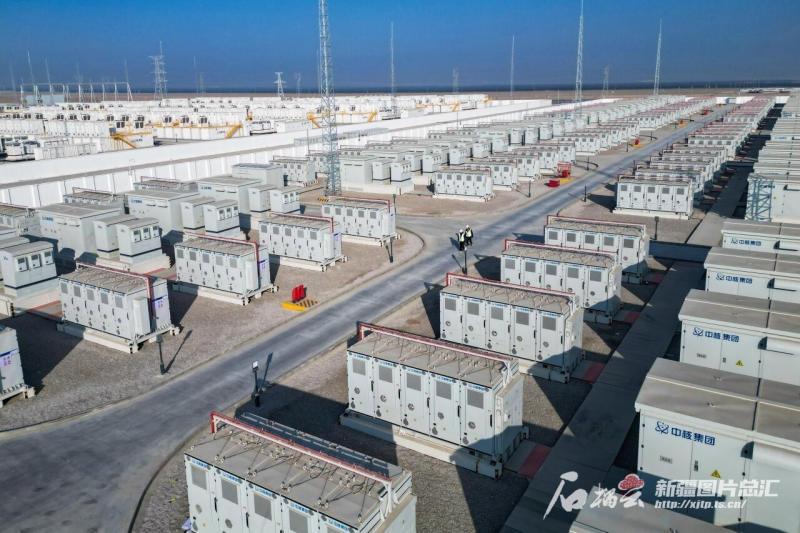Shiliuyun-Xinjiang Daily (Reporter Chen Qiangwei) news: According to the State Grid Xinjiang Electric Power Co., Ltd. on March 20, 2025, as of February, Xinjiang Uygur Autonomous Region has constructed over 200 new energy storage power stations, with a total installed capacity of 9.777 million kilowatts/32.663 million kilowatt-hours, ranking first in the country in terms of installed capacity of new energy storage.

Photo taken on January 9, 2025, shows staff members inspect the Xinhua Wushi 500,000 kilowatt/2 million kilowatt-hour grid-forming energy storage power station in Uqturpan County, Aksu Prefecture, northwest China’s Xinjiang Uygur Autonomous Region. (Photo by Shiliuyun-Xinjiang Daily/Cai Zengle)
The new electric power system is one of Xinjiang's top ten industrial clusters. In 2024, Xinjiang's new energy installed capacity exceeded 100 million kilowatts, making it the first province in the western China to achieve this milestone.
Xinjiang's new energy output exhibits a pattern of being higher in spring and autumn and lower in winter and summer, which contrasts with the grid's peak load during summer and winter, posing challenges to power supply security. By developing diversified energy storage, this single technological risk can be mitigated. As a new type of energy storage with technological innovation capabilities, high efficiency, and high-quality features, it is an essential component of the new power system and new energy system.
Today, Xinjiang is leveraging various energy storage methods to convert clean energy into stable and continuous electricity on a large scale. The new energy storage industry is becoming a regulator for Xinjiang's energy transition.
By February 2025, Xinjiang has approved the first and second batches of independent new energy storage projects with a total scale exceeding 11 million kilowatts. It is expected that by the end of 2025, the grid-connected scale of new energy storage in Xinjiang will surpass 20 million kilowatts.
In Xinjiang's 2024 roster of independent new energy storage projects, 41 independent new energy storage projects widely cover various types such as lithium iron phosphate, all-vanadium redox flow, sodium-ion batteries, compressed air, gravity storage, lead-carbon, hydrogen storage, and thermal storage. These diverse energy storage technologies hold broad application prospects in the energy sector.
"Currently, Xinjiang's energy storage development is characterized by scale, marketization, and diversification, which can effectively meet the needs of Xinjiang's new power system development," said Li Changling, deputy director of the Energy Development Research Center at the Economic and Technological Research Institute of State Grid Xinjiang Electric Power Co., Ltd.
In terms of scale, Xinjiang added 5.553 million kilowatts/19.529 million kilowatt-hours of new energy storage in 2024, a year-on-year increase of 139 percent, indicating rapid development. From a market perspective, Xinjiang has introduced supporting policies such as market entry trading, time-of-use pricing, and capacity compensation, clarifying investment expectations for energy storage and creating a favorable market development environment.
By February 2025, a total of 4,065 megawatts/16,260 megawatt-hours of energy storage projects, including the 1,000 million kilowatts/4,000 million kilowatt-hours independent new energy storage project at the Xinjiang Huadian Photovoltaic Base in Urumqi City, the Lixin 300 megawatts/1,200 megawatt-hours grid-forming independent energy storage project in Hetian County, and the Lixin 200 megawatts/800 megawatt-hours grid-forming independent energy storage project in Pishan County, have completed access system design reviews, indicating that Xinjiang's energy storage sector is entering a phase of rapid development.
During the 14th Five-Year Plan, Xinjiang has approved new energy storage projects with a total scale of 48.35 million kilowatts, including 34.12 million kilowatts of supporting energy storage projects and 14.23 million kilowatts of independent energy storage projects.
(A written permission shall be obtained for reprinting, excerpting, copying and mirroring of the contents published on this website. Unauthorized aforementioned act shall be deemed an infringement, of which the actor shall be held accountable under the law.)









